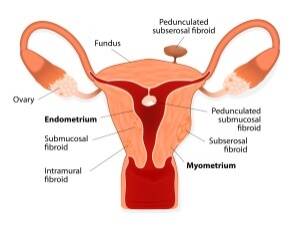What is a Laparoscopy?
 Laparoscopy is a surgical procedure your doctor may use to look at your uterus, ovaries, and fallopian tubes. If any problems are diagnosed, your physician may be able to address or correct the issue during this procedure.
Laparoscopy is a surgical procedure your doctor may use to look at your uterus, ovaries, and fallopian tubes. If any problems are diagnosed, your physician may be able to address or correct the issue during this procedure.
Laparoscopy is a fertility test that can help your doctor diagnose fibroids, scar tissue (adhesions), endometriosis, and blocked fallopian tubes – all of which can cause infertility. Using a narrow, fiberoptic telescope (called a laparoscope) inserted through a tiny incision near your navel, your doctor can examine your ovaries, fallopian tubes, and the outside of your uterus.
How is this procedure performed?
Laparoscopy is a short surgical procedure performed under general anesthesia, so it is usually done in a hospital setting or surgery center. Once you are under anesthesia, your doctor will insert a needle and inject a harmless gas into your abdomen. The gas raises the abdominal wall so that your doctor will be able to see your reproductive organs more clearly. The needles is removed and the laparoscope is inserted through a tiny incision. Another small incision is make in your lower abdomen so that your doctor can insert a probe. The probe is used to move or lift the organs to see hidden areas. Also, a dye may be injected through your cervix into your uterus and fallopian tubes to see if they are open or blocked. If your doctor sees a problem, it may often be treated at this time with a surgical instrument that is inserted through another small incision made in your lower abdomen.
QUESTION & ANSWERS
How soon can I go home after the procedure?
You will probably stay in the recovery room for about 3 or 4 hours after the procedure. When you recover from the anesthesia, you will be able to go home. You should plan to have someone take you home after the procedure and stay with you during the first 24 hours. In some cases, an overnight hospital stay may be required.
How will I feel for the next few days after the procedure?
Expect to feel sore and tired. You may feel pains in your shoulders and under your diaphragm. The pains are caused by gas bubbles from the procedure and should disappear in a day or two. Taking pain medication and walking or moving around should help relieve this pain. You should plan to take a few days off from work.
How many scars will I have and how large will they be?
Most patients will have 2 or 3 scars- the one near your navel will be about 1/2 inch long. The other scars in your lower abdomen will be about 1/4 inch long.
What are the risks of a laparoscopy?
Infection is the most common risk. Call your doctor if you:
- have a fever.
- see swelling or redness around your incisions or stitches.
- feel burning when you urinate or need to urinate frequently.
- have a discharge from the incision.
Other risks, which are rare, include complications from anesthesia and bleeding or injury to the bowel or bladder – which may be corrected during the laparoscopy.